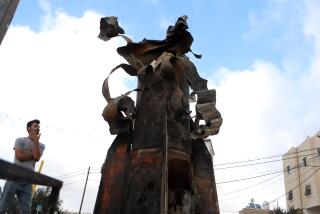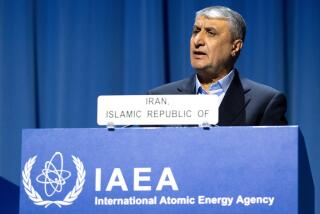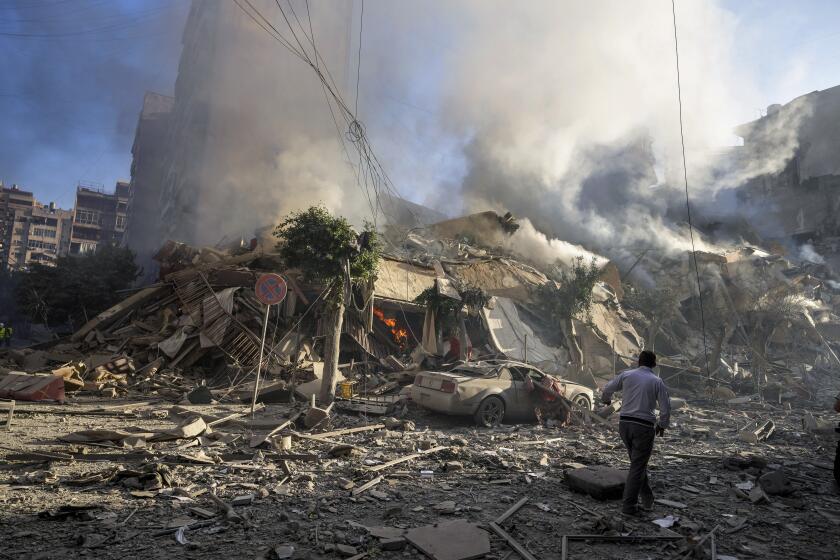Taking stock of Iran’s nuclear ambitions
What can the Obama administration do about Iran’s drive to develop nuclear weapons?
The president’s informal year-end deadline for a diplomatic resolution to the nuclear impasse with Iran has come and gone. Iran recently announced that it plans to build 10 nuclear fuel plants and has moved to enrich uranium to a higher level than necessary for peaceful purposes. As a result, the center of gravity within Washington policy circles is moving toward punitive measures against the Islamic Republic in the hope of curtailing its persistent nuclear ambitions.
Yet in order for the tougher measures it contemplates to be effective, the White House will need to know a lot more about the Iranian program than appears to be the case currently. A comprehensive reevaluation of what we know about Iran’s atomic drive -- and what it means -- is in order.
So far, the administration’s approach toward Iran has relied heavily on the conclusions of the 2007 National Intelligence Estimate, or NIE. But that report, with its central conclusion that Iran had ended its nuclear weapons program in 2003, turned out to be profoundly wrong on at least two counts.
The first was its presumption that Iran had halted work on nuclear weapons for an extended period of time. At the time, this claim was hotly contested by a host of other nations, which warned -- based on their own independent appraisals of the available intelligence -- that Iran’s internal nuclear weapons freeze had been fleeting, if it had ever existed at all.
Time has only added credibility to those more sober assessments. At the G-20 summit in Pittsburgh in September, President Obama and other Western leaders publicly revealed details concerning a secret nuclear site located in the Iranian city of Qom, a facility overseen by Iran’s Revolutionary Guard and convincingly linked to evidence of nuclear weapons work on the part of the Iranian regime. Just three months later, secret documents surfaced detailing Iran’s work on a neutron initiator. This is a trigger mechanism for nuclear weapons that specialists equate to a “smoking gun” indicating that Iran is developing a bomb.
The NIE’s second oversight was its complete disregard for Iran’s uranium enrichment activities. The stance was puzzling because the fabrication of fissile material is the crucial step in building a nuclear weapon. But the NIE explicitly excluded Iran’s “civil” nuclear program from its analysis -- thereby robbing it of any predictive capability for determining when Iran will have the raw material necessary to build a nuclear weapon, should it decide to do so.
The last two years have seen major movement on that score. By February 2009, the International Atomic Energy Agency, the United Nations’ nuclear proliferation watchdog, had concluded that Iran possessed a metric ton of low-enriched uranium -- a quantity sufficient to build one nuclear bomb, if enriched to weapons-grade. This stockpile is growing rapidly thanks to the expanding number of centrifuges in Iran’s inventory. As of last April, Iran could boast some 7,000 operational units; if the Iranian government meets its stated goals, that number will soon grow to more than 52,000. With such an “industrial” centrifuge capability, the Iranian regime would have the ability to produce enough weapons-grade uranium for nearly half a dozen nuclear weapons annually.
These intelligence failures warrant focused analysis now that U.S. policy toward Iran has reached a critical juncture. Recent news that the U.S. intelligence community has undertaken a partial reassessment of the conclusions of the 2007 NIE is welcome indeed. But it does not go far enough. The policy change now underway within the administration necessitates an equally sweeping reevaluation of what we know -- and what we don’t know -- about the status of Iran’s nuclear weapons program.
Such an assessment, moreover, must be carried out in concert with Congress and with input from private-sector experts. The experience of the misjudgments about Iran in the 2007 report makes clear that the NIE process itself is opaque and incomplete at best. At worst, it is susceptible to politicization -- something that could be avoided if a “Team B” approach involving competitive analysis were adopted.
In other words, in order to hold water with allies or the American public now, a rethinking of intelligence on Iran will need to take a different form -- one that is transparent, comprehensive in nature and inclusive of dissenting opinions. Just as important, it will need to account for the dynamism we have seen in Iran’s nuclear effort over the last two years.
Given how much progress Iran has made already, there’s no time to waste.
Ilan Berman is vice president of the American Foreign Policy Council in Washington. Robert C. McFarlane, former national security advisor to President Reagan, is chairman of a consulting firm specializing in national security and homeland security.
More to Read
Sign up for Essential California
The most important California stories and recommendations in your inbox every morning.
You may occasionally receive promotional content from the Los Angeles Times.










